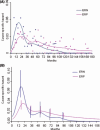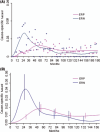Recurrence and mortality dynamics for breast cancer patients undergoing mastectomy according to estrogen receptor status: different mortality but similar recurrence
- PMID: 20132222
- PMCID: PMC11159972
- DOI: 10.1111/j.1349-7006.2009.01472.x
Recurrence and mortality dynamics for breast cancer patients undergoing mastectomy according to estrogen receptor status: different mortality but similar recurrence
Abstract
(Cancer Sci 2010; 101: 826-830) The purpose was to ascertain whether the recurrence risk patterns for patients with estrogen receptor (ER)-positive (P) and ER-negative (N) breast cancer support the ER-related clinical divergence suggested by the observed different mortality patterns and gene expression profiles. Both recurrence and death were considered in a series of 771 patients undergoing mastectomy. ER status was available for 539 patients. The hazard rates for recurrence and mortality throughout 15 years of follow-up were assessed. The recurrence dynamics displays a bimodal pattern for both ERP and ERN tumors with comparable peak timings. The two curves cross during the 3rd year. By contrast, the mortality dynamics are definitely different for ERP and ERN tumors: during the early follow-up period ERN patients have their highest mortality risk, while ERP patients have their lowest mortality risk. The two curves cross during the 5th year. In spite of the different mortality dynamics, the recurrence dynamics do not demonstrate a major distinction in timing between ERP and ERN breast cancers, suggesting that the metastasis development process following mastectomy is apparently similar for both ER categories. The observed differences in the mortality risk are plausibly attributable to ER-related factors influencing the clinical course from recurrence to death. These clinical findings apparently contradict the occurrence of two different types of breast cancer, notwithstanding the distinct epidemiological, clinical, and molecular features linked to ERP and ERN tumors, although ER levels may concur to establish the event risk levels.
Figures


References
-
- Knight WA III, Livingston RB, Gregory EJ et al. Estrogen receptor as an independent prognostic factor for early recurrence in breast cancer. Cancer Res 1977; 37: 4669–71. - PubMed
-
- Clark GM, McGuire WL. Steroid receptors and other prognostic factors in primary breast cancer. Semin Oncol 1988; 15: 20–5. - PubMed
-
- Raemaekers JM, Beex LVAM, Joenders AJM et al. The breast cancer group: disease‐free interval and estrogen receptor activity in tumor tissue of patients with primary breast cancer: analysis after long‐term follow‐up. Breast Cancer Res Treat 1985; 6: 123–30. - PubMed
-
- Hess KR, Pustzai L, Buzdar AU et al. Estrogen receptors and distinct patterns of breast cancer relapse. Breast Cancer Res Treat 2003; 78: 105–18. - PubMed
-
- Gray RJ. Flexible methods for analyzing survival data using splines, with application to breast cancer prognosis. J Am Stat Assoc 1992; 87: 942–51.
MeSH terms
Substances
LinkOut - more resources
Full Text Sources
Medical

